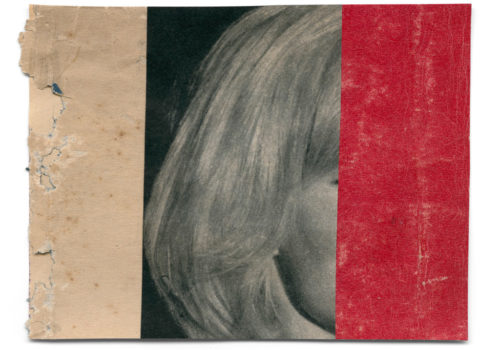Galerie Les filles du Calvaire presents Flemish artist Katrien de Blauwer for the first time in France.
Katrien de Blauwer has become a master in the art of “cutting”, a term that defines her practice better than “collage”, since the latter fails to express her mastery of the art of composition and the formal impact of her creations. In fact, her artworks are not collages in the usual sense. They are not about associating fragments in order to recreate images like the surrealists did for instance. Her artistic gesture originates from an intuitive perception and a poetical process, but her approach is conceptual and essential in nature. Katrien de Blauwer is a meticulous observer and a careful analyst of the various elements that make up a photograph whether in relation to the subject matter – how it captures a piece of reality through framing- but also the space within the image and the various plans and colors it is made of. However she is not directly a photographer. She prefers to pick and extract bits and pieces from others’ photographic language in order to revive their formal value.
Strictly speaking though, Katrien de Blauwer does not “cut out” since she does not follow the shapes of bodies or faces. She delimits visual strips and creates a composition ruled by abstract principles. She does not accumulate, she subtracts.
Her eyes single out a few visual elements and put a formal focus on them through the addition of mute colored strips that suggest an off-camera space and produce a new visual narration. Most elements these new images are composed of, and specifically the figurative parts, come from black and white magazines from the 1920’s to the 1960’s. She then combines them with monochromatic pieces of paper she collects from old books, aged paper bringing faded color effects, similar to black and white areas in newspaper clippings. Her range of colors creates a dialogue between different shades of grey and pantone hues, which adds to the graphic intensity of the whole.
Katrien de Blauwer’s radical Cuts draw on a minimal art culture. Even though her universe is different, her method is reminiscent of some conceptual artists from the 1960’s-70’s, such as the documentary approach of Dan Graham which consists in combining different types of photographical documents and presenting them like records gathered in catalogs, thus elaborating fictional urban typologies.
One can also think of Gordon Matta Clark’s urban practice, the architectural cuts of his projects on paper and the photographic records of his monumental interventions acting as “abstract” propositions. Katrien de Blauwer’s work is also influenced by contemporary fashion that she studied for some time.
On another level, “Cut” also refers to Katrien de Blauwer’s interest in cinema. We discovered her exceptional creations thanks to the book (I do not want to disappear silently into the night) she published in collaboration with Giuliana Prucca : a unique work – more of an artist book than a catalog- that revolves around Antonioni’s films. The universe of this maestro of black and white beautifully echoes Katrien de Blower creations. Finally, some of her compositions bring to mind L’année dernière à Marienbad by Resnais, while more troubling ones seem to allude to Hitchcock’s movies.
This cinematographic reference is central within her series entitled Dark scenes, Scenes, Single Cuts, Rendez-vous etc. The titles even pay an implicit tribute to the revolutionary editing techniques invented by Jean-Luc Godard, and especially to the “jump cuts”3 as he defined them. In some of Katrien de Blauwer’s Cuts, as in Singles – made of only two pieces of paper-, the notion of shot and movement-image seem to prevail over the “frame”. The cinematographic quality of her series is translated by the motion of some of her characters and accentuated by the artist editing which consists in the shifted repetition of images as if she had extracted one or two seconds shots from the film. Her plastic rendering takes the appearance of a movie fragment ripped from its narrative spine and exhibited as an out of time sequence.
One cannot write about Katrien de Blauwer’s work without highlighting its sensuality. Her work is profoundly feminine and the body parts she uses seem to come from black & white movies heroines, Italian neorealism and the French new wave of the 1950’s and 1960’s. The long or short hair fashion of her characters is reminiscent of Jeanne Moreau and Françoise Dorléac, while eyebrows raising above black strips recall Anna Karina and Silvana Mangano. On other pictures, one could recognize Monica Vitti’s voluptuous mouth or Jane Seberg’s delicate head, while the many pairs of legs across her work seem to invoke a fleeting yet eternal womanliness. For a French audience, some of her heroines could be taken out of Marguerite Duras’ novels, or come from Hollywood –for an American audience-, but in Katrien de Blauwer’s world,
they remain unique and mysterious.
This singular artist shares intimate fragments of her perception of Womanliness like visual jewels she has been scattering away for many years in what is already a vast body of work. Sometimes she gives away magnificent pieces for those who will be able to see them. It is up to the viewers to find the poetical path that will lead them to the heart of her images, and leave them astound and raptured in front of such small scale artworks, purposely made of humble materials, and yet charged with such formal intensity that it simply entirely takes you up.
EXHIBITION
Single Cuts
Katrien de Blauwer
From May 10th to June 18th, 2016
Galerie Les Filles du Calvaire
17 rue des Filles du Calvaire
75003 Paris
France
http://www.fillesducalvaire.com
http://www.katriendeblauwer.com
















